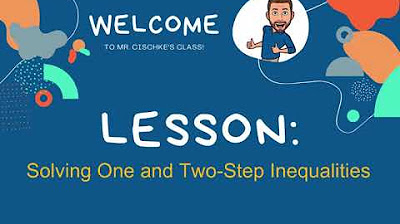How to Multiply
Summary
TLDRThis tutorial introduces a unique Japanese method of multiplying numbers visually by substituting digits with lines and dividing the pattern into zones. The process involves drawing lines for each digit, marking zones where lines intersect, and counting the intersections to get the product. Examples include multiplying 13 by 21 to get 273, and more complex calculations like 321 times 13 resulting in 4,000,173. The video demonstrates an alternative to traditional multiplication, though it humorously acknowledges that a calculator might be more practical.
Takeaways
- 📚 The video introduces a unique Japanese multiplication technique using lines to represent digits.
- 📝 The method involves drawing lines for each digit of the numbers involved in the multiplication.
- 🔢 The first digit dictates the number of lines drawn diagonally, with spaces for each subsequent digit.
- 📐 After drawing the lines, they are separated into zones where the lines cross each other.
- 🔍 Each zone is then counted for the number of line crossings, which contributes to the final multiplication result.
- 📉 For numbers larger than 9, the first digit is carried over to the next zone and added to its count.
- 🔄 The process is demonstrated with examples such as 13 x 21, 32 x 12, and 14 x 23.
- 📈 The technique can be applied to larger numbers, including three-digit multiplication, as shown with 321 x 13.
- 🤔 The video acknowledges that while the method is interesting, a calculator might be more practical for complex calculations.
- 👍 The presenter encourages viewers to explore more 'useless' tricks on their YouTube channel.
- 🎶 The video concludes with a light-hearted reminder to have fun and thanks the viewers for watching.
Q & A
What is the origin of the multiplication technique described in the video?
-The multiplication technique described in the video originates from Japan.
What is the basic concept of the multiplication method shown in the video?
-The basic concept involves substituting numbers for lines and drawing them in a specific pattern to visually represent the multiplication process.
How is the first part of the multiplication process demonstrated with the example of 13 times 21?
-The first part involves drawing lines for each digit of the numbers 13 and 21, with spaces in between, and then marking three separate zones where the lines cross.
What is the process of counting the lines in each zone after drawing them out?
-Starting from the right-hand zone, count the number of times any of the lines cross and write that number down, then move to the next zone and repeat the process.
What is the result of the multiplication example 13 times 21 using the described technique?
-The result of the multiplication example 13 times 21 is 273.
How does the technique handle the multiplication of numbers that result in a two-digit number in a zone?
-If the number of crosses in a zone is a two-digit number, the last digit is left in place, and the first digit is carried over to the next zone, where it is added to the number of crosses in that zone.
What is the result of the multiplication example 14 times 23 using the technique?
-The result of the multiplication example 14 times 23 is 322.
How does the technique adapt to multiplying larger numbers, such as a three-digit number by a two-digit number?
-The technique involves drawing lines for each digit of the larger numbers, marking out the zones, and counting the crosses in each zone, carrying over digits as necessary.
What is the result of the multiplication example 321 times 13 using the technique?
-The result of the multiplication example 321 times 13 is 4,000,173.
What advice does the video give if someone finds the multiplication technique difficult to follow?
-The video suggests using a calculator if the technique is difficult to follow.
How can viewers find more content like the multiplication technique shown in the video?
-Viewers can find more content by clicking on the links on the right-hand side or by visiting the presenter's YouTube channel page.
Outlines

Cette section est réservée aux utilisateurs payants. Améliorez votre compte pour accéder à cette section.
Améliorer maintenantMindmap

Cette section est réservée aux utilisateurs payants. Améliorez votre compte pour accéder à cette section.
Améliorer maintenantKeywords

Cette section est réservée aux utilisateurs payants. Améliorez votre compte pour accéder à cette section.
Améliorer maintenantHighlights

Cette section est réservée aux utilisateurs payants. Améliorez votre compte pour accéder à cette section.
Améliorer maintenantTranscripts

Cette section est réservée aux utilisateurs payants. Améliorez votre compte pour accéder à cette section.
Améliorer maintenantVoir Plus de Vidéos Connexes

Math Antics - Multi-Digit Multiplication Pt 2

Solving One and Two-Step Inequalities

Perkalian dan Pembagian Bentuk Akar Pangkat Dua/Kuadrat

Introduction to multiplying decimals | Decimals | Pre-Algebra | Khan Academy

Tutorial Lengkap: Konversi Bilangan Biner, Oktal, Desimal, dan Heksadesimal

8TH EDITION | BOOK 2 | EXERCISE 3A | QUESTION # 1, 2, 3
5.0 / 5 (0 votes)
